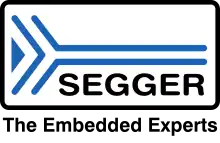Segger Microcontroller Systems
Segger Microcontroller, founded in 1992, is a private company involved in the embedded systems industry. It provides products used to develop and manufacture four categories of embedded systems: real-time operating systems (RTOS) and software libraries (middleware), debugging and trace probes, programming tools (integrated development environment (IDE), compiler, linker), and in-system programmers (Flasher line of products). The company is headquartered in Monheim am Rhein, Germany, with remote offices in Gardner, Massachusetts; Milpitas, California; and Shanghai, China.
 | |
| Type | GmbH |
|---|---|
| Industry | Embedded software |
| Founded | 1992 |
| Headquarters | Monheim am Rhein, Germany |
| Products | Middleware components, JTAG development tools |
| Website | www |
History
Segger Microcontroller was founded in 1992 by Rolf Segger in Hilden, Germany. The first product was the real-time operating system (RTOS), now named embOS. It was followed by emWin two years later. Initial products focused on RTOS and middleware products. However, the company later produced ISP-programming tools (Flasher) and debug probes (J-Link). In 2015, Segger introduced Embedded Studio, their cross-platform IDE for central processing units conforming to the ARM architecture, though recent versions are also used by RISC-V. All products are developed, maintained and updated in Germany except for Embedded Studio, which is primarily developed by a team of developers in the United Kingdom.
Product categories
Debug and trace probes
Segger is most noted for its J-Link family, which supports JTAG (Joint Test Action Group) and SWD (Serial Wire Debug) debug probes for microcontrollers that have older ARM cores (ARM7, ARM9, ARM11), ARM Cortex-M cores (M0, M0+, M1, M3, M4, M7, M23, M33, M85), ARM Cortex-R cores (R4, R5, R8), ARM Cortex-A cores (A5, A7, A8, A9, A12, A15, A17, A53, A72), Renesas RX, Microchip PIC32, SiLab EFM8, RISC-V.[1] It is also repackaged and sold as an OEM item[2] by Analog Devices as the mIDASLink, Atmel as the SAM-ICE, Digi International as the Digi JTAG Link, and IAR Systems as the J-Link and the J-Link KS. This is the only JTAG emulator that can add Segger's patented flash breakpoint software to a debugger to enable the setting of multiple breakpoints in flash while running on an ARM device which is typically hindered by the limited availability of hardware breakpoints.[3]
| Model | Host USB | Host Ethernet | Host Wi-Fi | Debug connector (Pitch) | Trace connector | Target voltage | Target max interface speed | Target max download speed | Target VCOM UART | Software features | Image |
|---|---|---|---|---|---|---|---|---|---|---|---|
| J-Trace PRO Cortex-A/R/M | 3.0 SS | 1 Gbit/s | None | 20-pin (0.1") | 19-pin 0.05" | 1.2V to 5V | 50 MHz | 3 MByte/s | 2 pins | All |  |
| J-Trace PRO Cortex-M | 3.0 SS | 1 Gbit/s | None | 20-pin (0.1") | 19-pin 0.05" | 1.2V to 5V | 50 MHz | 3 MByte/s | 2 pins | All |  |
| J-Trace PRO RISC-V | 3.0 SS | 1 Gbit/s | None | 20-pin (0.1") | 19-pin 0.05" | 1.2V to 5V | 50 MHz | 3 MByte/s | 2 pins | All |  |
| J-Link PRO | 2.0 HS | 100 Mbit/s | None | 20-pin (0.1") | None | 1.2V to 5V | 50 MHz | 3 MByte/s | 2 pins | All |  |
| J-Link ULTRA+ | 2.0 HS | None | None | 20-pin (0.1") | None | 1.2V to 5V | 50 MHz | 3 MByte/s | 2 pins | All |  |
| J-Link WiFi | 2.0 HS | None | 802.11b/g/n | 20-pin (0.1") | None | 1.2V to 5V | 15 MHz | 1 MByte/s | 2 pins | All |  |
| J-Link PLUS | 2.0 HS | None | None | 20-pin (0.1") | None | 1.2V to 5V | 15 MHz | 1 MByte/s | 2 pins | All |  |
| J-Link PLUS Compact | 2.0 HS | None | None | 20-pin (0.1") | None | 1.2V to 5V | 15 MHz | 1 MByte/s | 2 pins | All |  |
| J-Link BASE | 2.0 HS | None | None | 20-pin (0.1") | None | 1.2V to 5V | 15 MHz | 1 MByte/s | 2 pins | Limited |  |
| J-Link BASE Compact | 2.0 HS | None | None | 20-pin (0.1") | None | 1.2V to 5V | 15 MHz | 1 MByte/s | 2 pins | Limited |  |
| J-Link EDU | 2.0 HS | None | None | 20-pin (0.1") | None | 1.2V to 5V | 15 MHz | 1 MByte/s | 2 pins | Limited |  |
| J-Link EDU Mini | 2.0 FS | None | None | 9-pin (0.1") | None | 3.3V | 4 MHz | 0.2 MByte/s | None | Limited |  |
| J-Link OB | 2.0 FS | None | None | Integrated | None | Integrated | 4 MHz | 0.2 MByte/s | Depends | Limited |
- Note: Further models are J-Link LITE ARM, J-Link LITE CortexM, J-Link LITE RX, J-Link OEM.[5]
- Note: Software options vary by model: J-Flash, J-Flash-SPI, Ozone, RDDI, RDI, Unlimited Flash Breakponts.
- Note: The EDU & EDU Mini models cannot be used for commercial software development, also doesn't come with J-Flash, J-Flash-SPI, RDDI, RDI options.
- Note: Adapters and isolators are available to convert the 20-pin 0.1"/2.54mm male shrouded (box) header to another target board connector.[6]
- Note: The compact variants are functionally identical to the standard variants